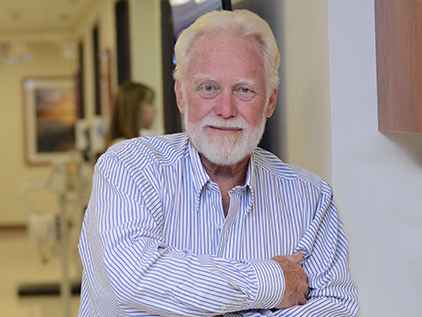- Home
- Types & Treatments
- Stereotactic Body Radiation Therapy
Stereotactic Body Radiation Therapy
As the only National Cancer Institute-designated comprehensive cancer center in the Kansas City region, The University of Kansas Cancer Center offers the most advanced radiation treatments and technologies. This includes short-course radiation therapy, called stereotactic body radiation therapy (SBRT), which involves delivering higher doses of radiation in fewer treatments.
Typically, radiation therapy may take weeks to complete, depending on the type and stage of cancer being treated. With SBRT, you receive 5 treatments or less over a span of 1-2 weeks. This advanced technology and innovative treatment dramatically reduces treatment time, is more manageable for you and reduces the overall dose of radiation. For example, while historically we treated prostate cancer with daily radiation treatment for 9 weeks, with more advanced SBRT technology we use at The University of Kansas Cancer Center we can treat prostate cancer in 1 week.
In addition, side effects and cure rates are equal to or better than when compared to conventional radiation treatment. The University of Kansas Cancer Center physicians have the most extensive and longest experience in the Kansas City region in offering SBRT treatment for a variety of cancers, including prostate cancer.
What is stereotactic body radiation therapy?
Stereotactic body radiation therapy administers radiotherapy from several different points around the body, with the radiation beams meeting at the spot of the tumor. The tumor receives a very high dose of radiation, while surrounding tissue receives less, lowering the risk of side effects and complications.
Who can have stereotactic body radiation therapy?
SBRT is used for a number of cancers, including prostate cancer, early-stage lung cancer, pancreatic cancer and some brain tumors. It is also used for cancers that have spread or metastasized to the lung, liver, brain, spine, bones or adrenal gland.
How does stereotactic body radiation therapy work?
SBRT is a noninvasive form of radiation treatment that involves high-dose radiation beams. It can deliver precisely targeted radiation in fewer high-dose treatments than traditional radiation therapy, which reduces the total amount of radiation to healthy tissue. SBRT requires advanced radiation technology that is available at The University of Kansas Cancer Center.

Beating prostate cancer without surgery
Don Hall was unable to receive standard therapy for prostate cancer. SBRT made it possible for him to get the treatment he needed in less time.
Don's story
Benefits and risks of stereotactic body radiation therapy
SBRT offers many advantages, including:
- Allows delivery of a higher dose of radiation to the tumor with fewer treatments
- Shows outcomes that are equal to or better than conventional radiation therapy
- Shortens treatment course, which is more convenient for you and not as disruptive to your life
- Reduces side effects, including fatigue
- More cost effective
Conventional radiation is typically delivered in small doses daily over many weeks. This can delay or interfere with other cancer treatments, such as chemotherapy. And many weeks of daily radiation treatment can significantly disrupt a patient’s life, including work. By contrast, SBRT can usually be given in 5 or fewer treatments. SBRT using advanced radiation technology also can lead to better outcomes and fewer side effects than conventional radiation therapy.
For prostate cancer, advanced SBRT reduces radiation treatment from 9 weeks to 1 week, and results in excellent long-term outcomes in terms of cure and quality of life. Physicians at The University of Kansas Cancer Center were among the first in the country to develop this advanced treatment for prostate cancer more than 10 years ago.
What happens during stereotactic body radiation therapy?
SBRT is delivered through a linear accelerator (radiation machine), which uses high-energy X-rays focused on the tumor. Radiation oncologists use a computerized system to shape the radiation beams to match a 3D outline of the tumor. The radiation oncologist collaborates with medical physicists to design a treatment plan that allows the delivery of radiation that conforms to the specific dimensions of the tumor and avoids nearby tissues and organs. Patients are awake and lying on a table during SBRT.
Why choose us
Currently, SBRT is offered at specialized cancer centers such as The University of Kansas Cancer Center, an NCI-designated cancer center. The University of Kansas Cancer Center offers the most advanced radiation technology, and its nationally renowned physicians have the most extensive experience using SBRT for a variety of cancers in the Kansas City region.
Request your appointment today.
To make an appointment at The University of Kansas Cancer Center, call 913-588-1227.